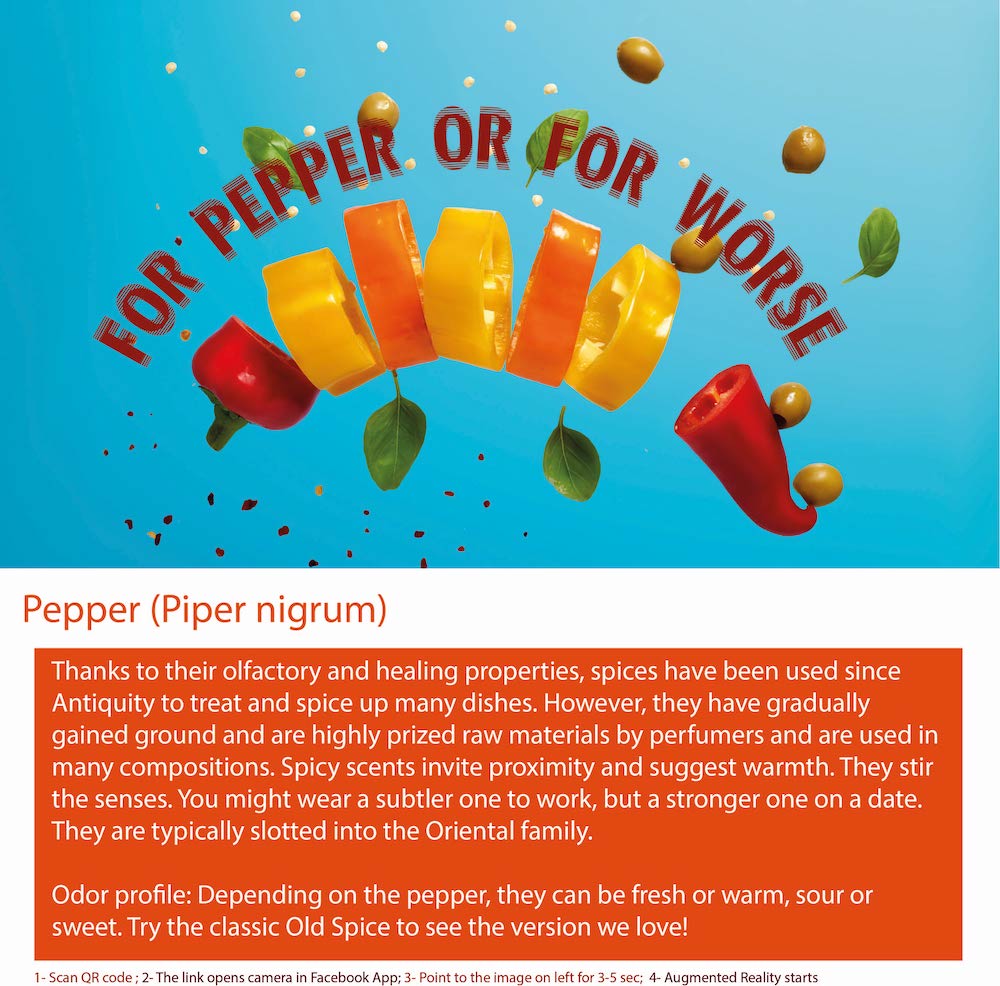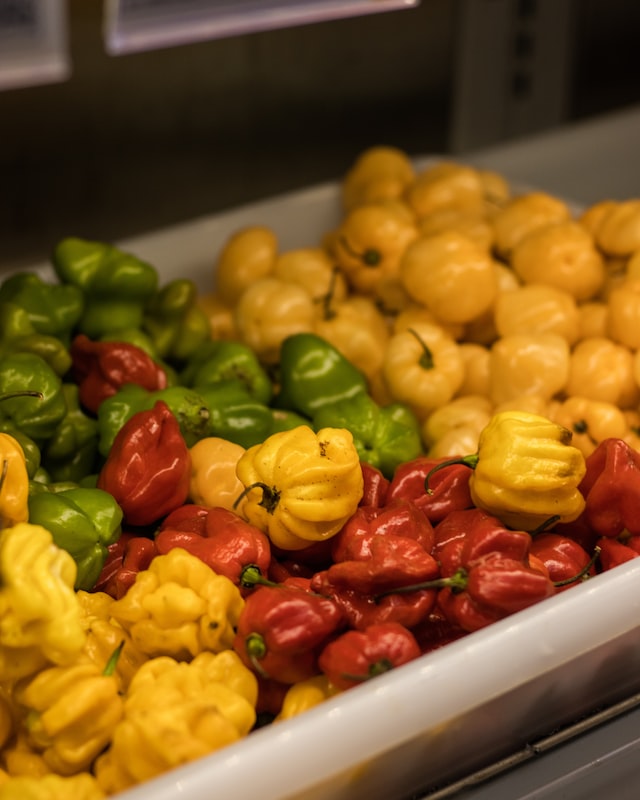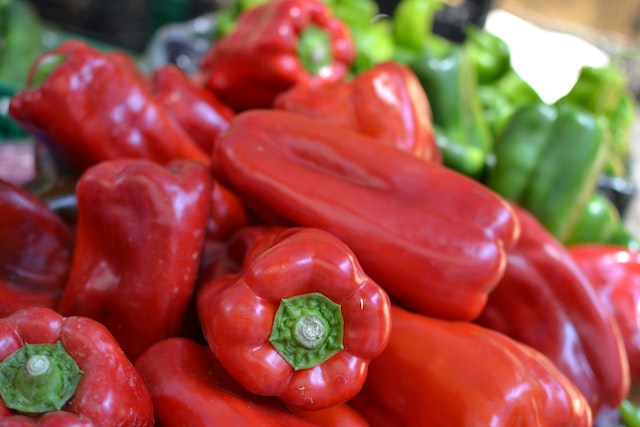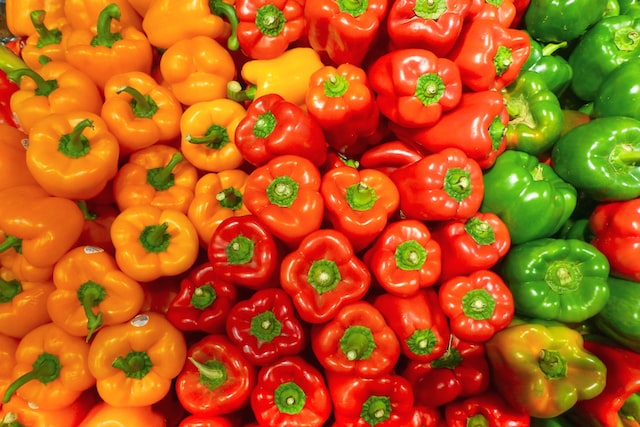Captivating Pepper Notes in Every Spray
Pepper: The Spicy Elixir of Flavor, Aroma, and Wellness
Introduction: Pepper, with its pungent and spicy allure, is an essential spice that has been a staple in culinary traditions and medicinal practices for thousands of years. Scientifically known as Piper nigrum, pepper belongs to the Piperaceae family and is celebrated for its distinctive flavor, aroma, and potential therapeutic properties. From enhancing the taste of various dishes to inspiring perfumers with its aromatic essence, pepper is more than just a spice. This essay delves into the captivating world of pepper, encompassing its presence in perfumes, therapeutic oils, food, medicinal systems, historical significance, and intriguing fun facts about this remarkable and cherished spice.
Culinary Delights and Flavors: Pepper is one of the oldest and most widely used spices in the world. It is available in different varieties, including black, white, green, and red, each with its unique taste and aroma. Pepper adds a zesty and warming flavor to a wide range of dishes, from savory to sweet, making it an indispensable ingredient in global cuisines.
Perfumes and Fragrance: While pepper is not commonly used in perfumery to extract essential oils, its aromatic properties have inspired perfumers to create synthetic compounds that mimic its spicy scent. Pepper-inspired fragrances may add a touch of warmth and spiciness to certain perfumes, creating a sense of energy and allure.
Therapeutic Oils and Aromatherapy: Pepper essential oil, extracted from the peppercorns, is highly valued in aromatherapy for its potential stimulating and invigorating properties. It is believed to promote mental clarity, increase energy, and improve circulation. Black pepper essential oil is a popular choice for adding a warming and spicy aroma to aromatherapy blends.
Medicinal Applications: Pepper has a long history of use in traditional medicine systems, particularly in Ayurveda and traditional Chinese medicine. It is believed to have potential digestive benefits, aiding in digestion and promoting healthy metabolism. Black pepper is also valued for its potential antibacterial and antioxidant properties.
Historical Significance: Pepper has played a significant role in human history. It was highly prized in ancient times and was even used as a form of currency in trade routes. The spice trade played a crucial role in connecting civilizations and shaping global history. Pepper was among the valuable spices that motivated European explorers to seek new trade routes, leading to the age of exploration.
Fun and Crazy Facts:
Introduction: Pepper, with its pungent and spicy allure, is an essential spice that has been a staple in culinary traditions and medicinal practices for thousands of years. Scientifically known as Piper nigrum, pepper belongs to the Piperaceae family and is celebrated for its distinctive flavor, aroma, and potential therapeutic properties. From enhancing the taste of various dishes to inspiring perfumers with its aromatic essence, pepper is more than just a spice. This essay delves into the captivating world of pepper, encompassing its presence in perfumes, therapeutic oils, food, medicinal systems, historical significance, and intriguing fun facts about this remarkable and cherished spice.
Culinary Delights and Flavors: Pepper is one of the oldest and most widely used spices in the world. It is available in different varieties, including black, white, green, and red, each with its unique taste and aroma. Pepper adds a zesty and warming flavor to a wide range of dishes, from savory to sweet, making it an indispensable ingredient in global cuisines.
Perfumes and Fragrance: While pepper is not commonly used in perfumery to extract essential oils, its aromatic properties have inspired perfumers to create synthetic compounds that mimic its spicy scent. Pepper-inspired fragrances may add a touch of warmth and spiciness to certain perfumes, creating a sense of energy and allure.
Therapeutic Oils and Aromatherapy: Pepper essential oil, extracted from the peppercorns, is highly valued in aromatherapy for its potential stimulating and invigorating properties. It is believed to promote mental clarity, increase energy, and improve circulation. Black pepper essential oil is a popular choice for adding a warming and spicy aroma to aromatherapy blends.
Medicinal Applications: Pepper has a long history of use in traditional medicine systems, particularly in Ayurveda and traditional Chinese medicine. It is believed to have potential digestive benefits, aiding in digestion and promoting healthy metabolism. Black pepper is also valued for its potential antibacterial and antioxidant properties.
Historical Significance: Pepper has played a significant role in human history. It was highly prized in ancient times and was even used as a form of currency in trade routes. The spice trade played a crucial role in connecting civilizations and shaping global history. Pepper was among the valuable spices that motivated European explorers to seek new trade routes, leading to the age of exploration.
Fun and Crazy Facts:
- Pepper Varieties: Black pepper is the most common and widely used variety. White pepper is black pepper with the outer skin removed, resulting in a milder taste. Green pepper is made from unripe berries, while red pepper (also known as pink or rose pepper) is made from fully ripe berries.
- Pepper's Heat: The heat of pepper comes from a compound called piperine, which stimulates the nerves and creates a sensation of spiciness.
- Pepper's Role in Medicine: In medieval Europe, pepper was believed to have medicinal properties, and it was used to treat various ailments, including stomachaches and sore throats.
- Pepper and the Spice Islands: The Moluccas, also known as the Spice Islands, were the primary source of pepper during the ancient and medieval eras.
- Pepper in Space: In 2000, NASA added black pepper to the menu of the International Space Station to enhance the taste of the astronauts' food.
To experience augmented reality, please open the Facebook-app using QR code and point to the image below
Experience the Allure of Oriental Exotic Fragrances
Pepper is a common spice made from the dried, ground berries of the Piper nigrum plant. It is used to add flavor and heat to a wide variety of dishes, and is one of the most popular spices in the world. It can be found in whole or ground form, and is often used in conjunction with salt to season food. Black pepper is the most common variety of pepper, but white, green, and pink peppercorns are also available.
Pepper has a long history of use, dating back to ancient times in India and Indonesia. It was highly valued by the ancient Egyptians, Greeks, and Romans, who used it as a seasoning, a medicine, and even as a form of currency.
In the Middle Ages, pepper became even more popular in Europe, where it was used to flavor food and as a medicine. The demand for pepper and other spices led to the exploration and colonization of new lands by European powers such as the Portuguese, Spanish, and Dutch. The search for a sea route to the East Indies, where pepper and other spices were grown, led to the discovery of the Americas.
The desire for pepper and other spices also played a major role in the development of the transatlantic slave trade as European powers sought to establish a source of cheap labor to work on their plantations in the colonies. The trade in pepper and other spices also led to the establishment of trading posts, forts, and colonies in India, Indonesia, and other parts of Southeast Asia.
In summary, pepper played a major role in the history of colonization, as European powers sought to control the trade in this valuable commodity. The desire for pepper and other spices led to the exploration and colonization of new lands, the development of trade networks, and the establishment of colonies and trading posts around the world.
Pepper has a long history of use, dating back to ancient times in India and Indonesia. It was highly valued by the ancient Egyptians, Greeks, and Romans, who used it as a seasoning, a medicine, and even as a form of currency.
In the Middle Ages, pepper became even more popular in Europe, where it was used to flavor food and as a medicine. The demand for pepper and other spices led to the exploration and colonization of new lands by European powers such as the Portuguese, Spanish, and Dutch. The search for a sea route to the East Indies, where pepper and other spices were grown, led to the discovery of the Americas.
The desire for pepper and other spices also played a major role in the development of the transatlantic slave trade as European powers sought to establish a source of cheap labor to work on their plantations in the colonies. The trade in pepper and other spices also led to the establishment of trading posts, forts, and colonies in India, Indonesia, and other parts of Southeast Asia.
In summary, pepper played a major role in the history of colonization, as European powers sought to control the trade in this valuable commodity. The desire for pepper and other spices led to the exploration and colonization of new lands, the development of trade networks, and the establishment of colonies and trading posts around the world.
Unveiling the Essence of Our Oriental Exotic Men Fragrance
Pepper cultivation has been an important source of income for many farmers and communities throughout history. The trade in pepper and other spices was a major driver of the economy in the regions where they were grown, such as India and Indonesia.
However, the trade in pepper and other spices also led to conflicts and wars between European powers and local kingdoms and empires. European powers such as the Portuguese, Dutch and British fought to control the trade in pepper and other spices, and establish their own trading posts and colonies in the regions where they were grown. They also engaged in wars with local kingdoms and empires to gain control of these valuable resources.
The competition for control of pepper and other spices also led to the establishment of monopoly trade systems, where European powers would control the trade in these commodities and set prices. This led to an increase in the price of pepper and other spices, making them even more valuable.
In addition, the cultivation of pepper and other spices also led to the displacement of local communities and the destruction of native ecosystems in these regions.
In summary, pepper cultivation and trade had a significant impact on the economy and society of the regions where it was grown, but it also led to conflicts and wars between European powers and local kingdoms and empires, as well as the establishment of monopoly trade systems and the displacement of local communities and destruction of native ecosystems.
However, the trade in pepper and other spices also led to conflicts and wars between European powers and local kingdoms and empires. European powers such as the Portuguese, Dutch and British fought to control the trade in pepper and other spices, and establish their own trading posts and colonies in the regions where they were grown. They also engaged in wars with local kingdoms and empires to gain control of these valuable resources.
The competition for control of pepper and other spices also led to the establishment of monopoly trade systems, where European powers would control the trade in these commodities and set prices. This led to an increase in the price of pepper and other spices, making them even more valuable.
In addition, the cultivation of pepper and other spices also led to the displacement of local communities and the destruction of native ecosystems in these regions.
In summary, pepper cultivation and trade had a significant impact on the economy and society of the regions where it was grown, but it also led to conflicts and wars between European powers and local kingdoms and empires, as well as the establishment of monopoly trade systems and the displacement of local communities and destruction of native ecosystems.
Pepper fun facts:
- Pepper is the most widely traded spice in the world, with more than 24 million tons produced annually.
- Black pepper is actually the unripe fruit of the pepper plant. The berries are picked before they are ripe and then left to dry in the sun, which causes them to turn black.
- White pepper is made from ripe pepper berries that have had their outer layer removed.
- The ancient Greeks and Romans used pepper to pay taxes and rent.
- Pepper was so valuable in medieval Europe that it was sometimes used as collateral for loans or even used to pay for a bride's dowry.
- In the 14th century, a pound of pepper was worth about the same as a sheep or a cow.
- In the Middle Ages, pepper was believed to have medicinal properties and was used to treat a variety of ailments, including headaches, toothaches, and even the plague.
- Pepper is also believed to have antimicrobial properties, making it useful for preserving food.
- The pepper plant is a climbing vine that can grow up to 33 feet tall.
- The pepper plant is native to India and Indonesia, but is now grown in many tropical regions around the world.
Crafted with Care: The Pepper-Infused Cologne Difference
Pepper is a popular spice in many different types of cuisine around the world. It is known for its strong, pungent flavor and aroma and is used to add depth and complexity to dishes.
In Western cuisine, black pepper is a staple spice that is often used to season meats, soups, stews, and marinades. It is also commonly used in salad dressings and dips, as well as in many different types of cheese.
In Indian cuisine, black pepper is often used in curries and other spicy dishes, as well as in chutneys and pickles. It is also a key ingredient in many different types of masalas, which are spice blends used to flavor curries and other dishes.
In Chinese cuisine, black pepper is commonly used in stir-fries, marinades, and sauces. It is also used to season meat dishes, such as Kung Pao chicken and Szechuan beef.
In Southeast Asian cuisine, black pepper is often used in soups, stews, and curries. It is also used to season seafood dishes, such as Nasi Goreng in Indonesia.
In addition to black pepper, white pepper, green pepper and pink pepper are also used in many different types of cuisine. White pepper is commonly used in light-colored sauces, soups, and stews, as well as in Chinese and Thai cuisine. Green pepper is often used in salads, dressings, and marinades. Pink pepper is often used in Mediterranean and French cuisine.
Overall, pepper is a versatile spice that adds depth and complexity to dishes in many different types of cuisine around the world.
In Western cuisine, black pepper is a staple spice that is often used to season meats, soups, stews, and marinades. It is also commonly used in salad dressings and dips, as well as in many different types of cheese.
In Indian cuisine, black pepper is often used in curries and other spicy dishes, as well as in chutneys and pickles. It is also a key ingredient in many different types of masalas, which are spice blends used to flavor curries and other dishes.
In Chinese cuisine, black pepper is commonly used in stir-fries, marinades, and sauces. It is also used to season meat dishes, such as Kung Pao chicken and Szechuan beef.
In Southeast Asian cuisine, black pepper is often used in soups, stews, and curries. It is also used to season seafood dishes, such as Nasi Goreng in Indonesia.
In addition to black pepper, white pepper, green pepper and pink pepper are also used in many different types of cuisine. White pepper is commonly used in light-colored sauces, soups, and stews, as well as in Chinese and Thai cuisine. Green pepper is often used in salads, dressings, and marinades. Pink pepper is often used in Mediterranean and French cuisine.
Overall, pepper is a versatile spice that adds depth and complexity to dishes in many different types of cuisine around the world.
Indulge in Luxury: Our Collection of Men's Fragrances
Pepper has a distinct, pungent aroma that is often described as woody, spicy, and warm. The scent of black pepper is considered to be the most complex, with notes of wood, pine, and juniper. The aroma of white pepper is considered to be milder and less complex, but still has a spicy, pungent scent. Green pepper has a fresher, more vegetal aroma, and pink pepper has a more floral and fruity aroma.
Black pepper is known to have a strong, sharp, and slightly sweet aroma. It has notes of wood and pine, with a hint of fruitiness. The aroma is also described as being warm and slightly smoky, with a hint of peppermint.
White pepper has a more delicate aroma, but still retains a spicy, pungent scent. It has a milder, less complex aroma than black pepper, with notes of wood, pine, and juniper.
Green pepper has a fresher, more vegetal aroma, with notes of grass and hay. It has a bright, clean and a slight hint of lemon.
Pink pepper has a more floral and fruity aroma, with notes of rose, berry, and citrus. It is considered to be less pungent and more delicate than black and white pepper.
In summary, pepper has a distinct, pungent aroma that is often described as woody, spicy, and warm. The aroma of black pepper is considered to be the most complex, with notes of wood, pine, and juniper, while white pepper has a more delicate aroma, with notes of wood, pine, and juniper. Green pepper has a fresher, more vegetal aroma, and pink pepper has a more floral and fruity aroma.
Black pepper is known to have a strong, sharp, and slightly sweet aroma. It has notes of wood and pine, with a hint of fruitiness. The aroma is also described as being warm and slightly smoky, with a hint of peppermint.
White pepper has a more delicate aroma, but still retains a spicy, pungent scent. It has a milder, less complex aroma than black pepper, with notes of wood, pine, and juniper.
Green pepper has a fresher, more vegetal aroma, with notes of grass and hay. It has a bright, clean and a slight hint of lemon.
Pink pepper has a more floral and fruity aroma, with notes of rose, berry, and citrus. It is considered to be less pungent and more delicate than black and white pepper.
In summary, pepper has a distinct, pungent aroma that is often described as woody, spicy, and warm. The aroma of black pepper is considered to be the most complex, with notes of wood, pine, and juniper, while white pepper has a more delicate aroma, with notes of wood, pine, and juniper. Green pepper has a fresher, more vegetal aroma, and pink pepper has a more floral and fruity aroma.
Shop the Best Men's Cologne Online in Singapore
There are many famous perfume brands that have used pepper as a key ingredient in their fragrances. Some notable examples include:
- Tom Ford: Tom Ford's "Black Orchid" is a popular fragrance that features black pepper as one of its key notes. This scent is described as being dark and mysterious, with notes of black truffle, patchouli, and vanilla.
- Jo Malone: Jo Malone's "Black Pepper" cologne is a popular fragrance that features black pepper as its main note. This scent is described as being warm, spicy, and woody, with notes of ginger, coriander, and tonka bean.
- Prada: Prada's "Amber Pour Homme" is a popular fragrance that features pink pepper as one of its key notes. This scent is described as being warm, spicy, and woody, with notes of amber, patchouli, and vanilla.
- Yves Saint Laurent: Yves Saint Laurent's "Black Opium" is a popular fragrance that features pink pepper as one of its key notes. This scent is described as being dark and mysterious, with notes of coffee, white flowers, and vanilla.
- Dior: Dior's "Sauvage" is a popular fragrance that features pink pepper as one of its key notes. This scent is described as being fresh, spicy, and woody, with notes of bergamot, lavender, and ambroxan.
- Versace: Versace's "Eros" is a popular fragrance that features black pepper as one of its key notes. This scent is described as being masculine, spicy, and woody, with notes of lemon, tonka bean, and vanilla.
Join Scentopia, Sentosa's latest tourist attraction wonderful orchid scent crafting, fragrance tour, bridal shower or corporate team building which includes perfume making onsite and offsite, beach activities and more. We also serve primary school learning journey, secondary students and pupil on industrial excursions. Know more about our orchids perfume bar or therapeutic orchid scents and other wellness aromas. Conatct Perfume workshop or book a scent crafting session here.







